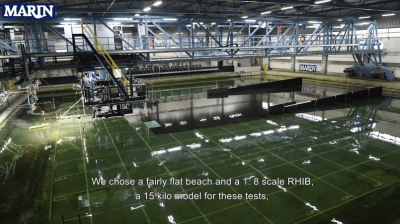Today’s landing craft sail faster and faster. So how do you navigate breaking waves for a safe and controlled landing and retreat? Commissioned by the Dutch Ministry of Defence (Ministerie van Defensie), MARIN has built a special test environment in its Offshore Basin to explore the variables for testing amphibious operations: Operation Blue Beach.
Sailing through the surf zone near a beach during an amphibious landing can be a dangerous operation as sailing with a landing craft through following breaking waves can pose challenges on the course keeping ability and surf riding that may lead to large uncontrolled roll and/or pitch motions. Assessing the safety of a landing craft in these operations cannot be done by traditional static stability calculations, as these do not capture the highly dynamic forces well. Also, in our view, there are no practical and sufficiently accurate time domain simulation models available (development of such simulation capability is part of the Defence Program V1912 Seamulator) . That leaves model tests as only viable option to assess the safety of an amphibious operation for now. At the same time, a model test of an amphibious operation is very different from an ordinary seakeeping test, due to the changing bathymetry and changing waves over the run and the influence of the operator during each approach.
Navies currently are modernizing their amphibious forces, which leads to high performance landing crafts, having for example much higher speeds than the traditional landing crafts. These more advanced crafts may have different behaviour while traveling through the surf zone. This potentially leads to a higher need of model testing of these operations. To offer technically good and cost effective amphibious testing capability to our clients, MARIN performed a testing campaign to develop a new approach to perform these tests, in order to:
- Develop a cost effective removable beach structure that could be built in either the Offshore Basin or Shallow Water Basin;
- Get a better understanding of relevant aspects of sailing through the surf near a beach;
- Develop a standard approach for amphibious tests.
During this test campaign we learned many do’s and don’ts. Now we are in the process of translating these findings into a new procedure for future testing.
Video:
Interested? Contact Eelco Harmsen for more information.
Eelco Harmsen:


